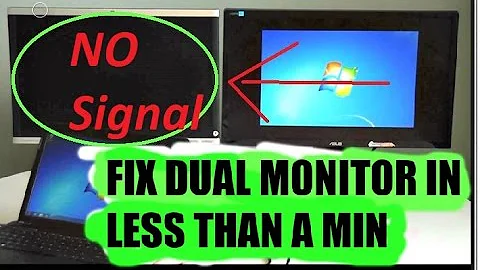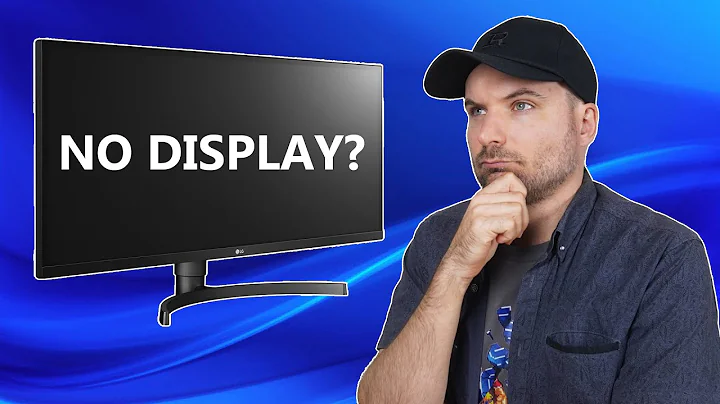External monitor recognized but getting "no signal"
Solution 1
I had the exact same problem as the question poster: Ubuntu 12.10, Nvidia card, monitor connected via HDMI, using nouveau driver, monitor worked before (with the same setup), the monitor is detected and enabled in Ubuntu, but no signal to monitor.
The temporary solution: I'm running Ubuntu on a laptop and there is a special key on my keyboard which allows me to enable/disable external displays (in my case the key is Fn + F7, this differs per laptop). So I just pressed that key combination and the external monitor immediately was turned on.
EDIT:
Though the key combination to enable the external monitor works, you'll have to repeat this every time you reboot. I found a way to have the external monitor automatically detected and enabled at the login screen (after a reboot). And when you login, the previous settings for your monitors are restored, as you would expect. Here's how to do it:
Note: I only tested this with an Nvidia card. And before you continue, I recommend you install SSH first (sudo apt-get install ssh) to be safe. In the case something goes wrong and both internal and external monitor stop working, you can always undo whatever you did by logging in from another computer via SSH (e.g. ssh [email protected]). So make sure you know the IP address of your computer in the network.
First of all, run
sudo apt-get install v86din a terminal to install thev86dpackage.Run
gksu gedit /etc/initramfs-tools/modulesorsudo vim /etc/initramfs-tools/modulesand add the following line at the end of the file (replace1280x1024by the resolution of your internal monitor):uvesafb mode_option=1280x1024-24 mtrr=3 scroll=ywrap
save and exit.
Create the file
/etc/initramfs-tools/conf.d/splashby runninggksu gedit /etc/initramfs-tools/conf.d/splashorsudo vim /etc/initramfs-tools/conf.d/splashwith the following content:FRAMEBUFFER=y
save and exit
Now you need to update the initramfs image because we changed some configurations. Do this by runnning
sudo update-initramfs -u.
Now reboot your system and your external monitor should get a signal as soon as the Ubuntu login screen appears.
Solution 2
I used nvidia-settings command to enable external monitor (selected TwinView mode). Note native "Gnome Classic" Displays configuration dialog did not detect external monitor. This was on Ubuntu 12.04.
Martin
Solution 3
I had a similar problem on an Ubuntu 12.04 desktop with an Geforce GT 640 (Baby Kepler version) and the nVidia 310 drivers. When disconnecting and reconnecting a second monitor, in all trials expect one, the monitor seemed to be working properly: correct EDID, detecting monitors works properly, mouse moves off screen to other monitor's area, nvidia-settings reports proper info for both monitors.
However, the monitor reports 'no signal', displays no image, and otherwise acts as if it was stuck in dpms suspend mode. Disconnecting the monitor also worked as expected, and the system would reconfigure for single monitor mode.
Issuing:
sudo vbetool dpms on
resolved the issue. Of course if you don't have vbetool installed, you'll need to run:
sudo apt-get install vbetool
to install it. I suspect in my case a reboot or logging in and out would have also fixed my issue, but since it was resolved by the above command I didn't get to test that thoery (nor do I really want to, of course). note that various actions in nvidia-settings (such as changing resolution, enabling/disabling various monitors, and so on) had no effect.
Related videos on Youtube
Admin
Updated on September 18, 2022Comments
-
 Admin over 1 year
Admin over 1 yearI'm running 12.10 dual booted with windows 7 (nvidia optimus). I have no idea what might be wrong because:
- the monitor works on windows
- it worked on ubuntu for over a year and even now the splash screen shows up on the external monitor while ubuntu is booting
- the monitor is detected and shows up in the workspace switcher
- I connected it to another monitor through hdmi and it works fine
- it works fine through VGA (but for some reason it's not as sharp)
- changing the resolution didn't help
- changing cables didn't help
here's my xrandr output:
Screen 0: minimum 320 x 200, current 3286 x 1080, maximum 8192 x 8192 LVDS1 connected 1366x768+0+0 (normal left inverted right x axis y axis) 293mm x 164mm 1366x768 60.0*+ 1360x768 59.8 60.0 1024x768 60.0 800x600 60.3 56.2 640x480 59.9 VGA1 disconnected (normal left inverted right x axis y axis) HDMI1 connected 1920x1080+1366+0 (normal left inverted right x axis y axis) 531mm x 299mm 1920x1080 60.0*+ 50.0 60.0 25.0 30.0 1600x1200 60.0 1680x1050 59.9 1680x945 60.0 1400x1050 74.9 59.9 1600x900 60.0 1280x1024 75.0 60.0 1440x900 75.0 59.9 1280x960 60.0 1366x768 59.8 1360x768 60.0 1280x800 74.9 59.9 1152x864 75.0 1280x768 74.9 60.0 1280x720 50.0 60.0 1024x768 75.1 70.1 60.0 1024x576 60.0 832x624 74.6 800x600 72.2 75.0 60.3 56.2 720x576 50.0 848x480 60.0 720x480 59.9 640x480 72.8 75.0 66.7 60.0 59.9 720x400 70.1 DP1 disconnected (normal left inverted right x axis y axis)-
 Admin about 11 yearsI have the same problem. I don't if it helps but for me the problem started occurring this morning (after 10 months without any issues) as I boot up my laptop. Maybe an update which I installed yesterday evening broke something
Admin about 11 yearsI have the same problem. I don't if it helps but for me the problem started occurring this morning (after 10 months without any issues) as I boot up my laptop. Maybe an update which I installed yesterday evening broke something -
 Admin over 10 yearsI have the same issue as of 10/22/2013 with Ubuntu 12.04 LTS and Intel HD integrated graphics. I've found that it works as expected in "Ubuntu 2D" desktop mode.
Admin over 10 yearsI have the same issue as of 10/22/2013 with Ubuntu 12.04 LTS and Intel HD integrated graphics. I've found that it works as expected in "Ubuntu 2D" desktop mode.
-
Serrano Pereira over 11 yearsI have the same problem (and the monitor worked before). I tried your solution, but no effect (besides, I was already using the nouveau driver).
-
perimosocordiae almost 10 yearsThis worked, but also resulted in a complete screen lockup (with Nvidia drivers). I ended up having to reboot anyway.
-
 Admin about 2 yearsThis does not really answer the question. If you have a different question, you can ask it by clicking Ask Question. To get notified when this question gets new answers, you can follow this question. Once you have enough reputation, you can also add a bounty to draw more attention to this question. - From Review
Admin about 2 yearsThis does not really answer the question. If you have a different question, you can ask it by clicking Ask Question. To get notified when this question gets new answers, you can follow this question. Once you have enough reputation, you can also add a bounty to draw more attention to this question. - From Review -
 Admin almost 2 years@David though it's not a direct answer to the question, it is important to refer this behavior still exists in a new version of Ubuntu. Should I duplicate the same question and only differ in Ubuntu version?
Admin almost 2 years@David though it's not a direct answer to the question, it is important to refer this behavior still exists in a new version of Ubuntu. Should I duplicate the same question and only differ in Ubuntu version?



![FIX: Windows 10 Not Detecting Second Monitor [Quick Tutorial]](https://i.ytimg.com/vi/VI85Qfq41Hk/hqdefault.jpg?sqp=-oaymwEcCOADEI4CSFXyq4qpAw4IARUAAIhCGAFwAcABBg==&rs=AOn4CLAvmH6Uqi0qlvPdb1aElGnMPPSWOA)
